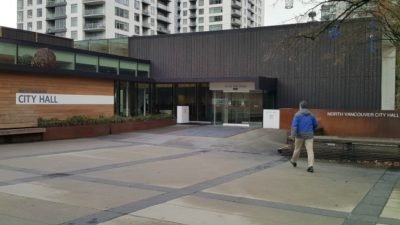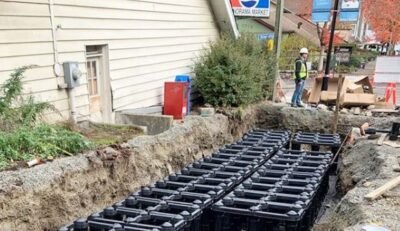District of North Vancouver councillors have agreed to open a dialogue with East 29th Street residents after Councillor Lisa Muri brought back the issue of removal of on street parking to last night’s council meeting.
In a unanimous vote, council asked staff to report back on the issues and solutions highlighted by the residents of East 29th Street at an upcoming council meeting on July 22. Council also asked staff to hold a public input meeting with the residents of 29th Street and surrounding neighbourhoods to discuss the impacts of the removal of parking.
Coun. Muri acknowledged that that residents have been caught off-guard and were left frustrated with the direction taken by the council.
“The original report written by Steve Carney in DNV’s traffic department contemplated a holistic approach of shared bike lanes and improved intersections. At no time during the two public input sessions did complete removal come up,” Muri noted.
She said that if council wanted to remove all parking from arterial roads, then they need to understand the impact such a decision would have in area like Delbrook and Deep Cove, where residents have no option but to park on the street. Protecting pedestrians and cyclists is a priority of the current council, but it needs to take a holistic picture of how people get around in the district, she said.
“If a safer more user friendly road network is to succeed, then we need to have users and neighbourhoods working together to come up with solutions. We should be balancing, and listening to the needs of all users of our roadways, not dividing our community,” she said.
Mayor Mike Little supported opening a dialogue with residents but made it clear the roads can’t be allowed to use as storage for private vehicles in the future. He said he was willing to solutions such as a pull-out space or short term parking solution, but the arterial roads are too valuable to be used for private parking.
“The real estate from curb to curb is a really valuable space, and I’d have great concerns spending money on the roads which are being used for private vehicle storage,” he said.
He had support in other councillors as well. Councillor Matthew Bond said the district needs to prioritize safe movement of people and there is a need to change the way things have been done. Hanson agreed with Little that going forward arterial roads can’t be used for parking. “I am interested in parking mitigation, but not in investment for private storage of vehicles,” he said. Councillors Megan Curren and Betty Forbes were sympathetic to the residents but said cycling and transit needs would have to be considered on arterial roads.









This is bs transit cyclists and vehicles need to co exist but right now all council wants to do is make it harder to get around. So of those houses don’t have driveways and last time i saw you had to have insurance to park on the street. Besides why put bike lanes in when they hardly get used especially on that hill. As far as im concerned cyclists don’t pay any insurance so why are you wasting the homeowners tax money.
Interesting how council calls it “private vehicle storage” when it is in fact essential, temporary parking for daycares, residents, amazon deliveries, municipal garbage pick up etc. Are they going to disallow parking on other streets as well?
Transit already has stops on 29th so using that is a weak argument. Very few cyclists prefer to use main arteries. They usually opt for more scenic, quieter routes that have less traffic.
Has there even been studies on cyclist use compared to other routes?
The residents of 29th were railroaded without proper due consideration.
It would be interesting to know if the councillors would have had the same comments if Mike Little had not spoken first..perhaps these are “followers” not leaders. It just about seems that Lisa Muri is the only one that can think for herself and logically.
Storage for private vehicles??? Give me a break…what about 13th Street or 15th Street or 19th Street..they are all “cross overs..what about Queens..what about Lonsdale..oh, perhaps some councillors do not commute on their bicycles on those streets..perhaps catty..but this a personal agenda not a community concern? A holistic approach would be very unselfish and the only way to resolve. Let’s see what happens..I am sure most of the people would remember the names of councillors who work for the people next elections verses those who works for their own interests..it’s all about money!
Hi Kat. 29th Street has been slated as a designated bike route for years – it’s on the Bike Master Plan, last approved way back in 2012. These routes have been carefully worked out based on all kinds of criteria including grades, vehicle traffic volumes, and connectivity with other bike-suitable streets. And, on the contrary, people getting around by bike actually do prefer safe, convenient, and DIRECT routes and not the meandering, “scenic” routes.
Martyn Schmoll I understand that cyclists also prefer designated bike lanes that are not on B-Line streets. Will cyclists speak up against transit improvements when a B-Line bus route is set on the steep 29th Street East?
As I have said, we’re not against cyclists and it’s immature and ignorant to create the notion that this is otherwise. The ‘master plan’ for bikes needs an updated review, something that was also brought up on Monday nights DNV Council meeting. The changes in this neighbourhood since 2012 are vast. Implementing plans based off something from 7 years ago is a misrepresentation. Perhaps you should read up on current conditions, data collection, density, street usage needs along 29th Street East. Oh right, those involved with this project cannot provide that because they didn’t thoroughly do their jobs.
I have lived on east 29th St for 38 years. This is a totally ridiculous design. If safety is a concern then enforce the speed limit or possibly reduce it to 40kph. Left turn lanes are an overkill, let’s see the stats. Crosswalks are a welcome improvement, but that is only the cost of paint. Why is a bus stop being eliminated, if you want the people to use public transit, it must be convenient? If there is no room for a dedicated bike lane, then simply call it a bike route and erect a few signs. With some common sense everyone will be happy.
Mayor Little stated at the Monday, July 8, 2019 DNV Council meeting that public roads, including major arterial roads are for all users. This would then include users who require on-street parking.
Mayor Little then went on to say that these roads are not for the storage of private vehicles. Storing vehicles is not what any of the many on-street parking users along 29th Street East are wanting to do, they are simply looking to utilize on-street parking. Those utilizing on-street parking include guests, visitors, clients, staff, delivery services, postal services, drop off and pick up needs, care attendants who assist those in their homes, HandyDART and other mobility and disability challenged providers, taxis, local businesses who are hired by the residents along 29th Street East, tenants who have varied and dynamic needs, home based businesses and the residents themselves.
Approximately 200 on-street parking spots are about to simply vanish, with no plans in place on how to support those on-street parking, temporary stopping, service providing or mobility challenged needs. Mayor Little talked about wanting to save money. It will certainly cost a lot more to fix the mistakes and omissions of this project should it go to completion in the way the current maps provided demonstrate. Mayor Little threw the climate conversation at the 29th Street East on-street parking needs. He did not consider the increase in idling one will have when they are stuck behind the service trucks on Garbage/Recycling days due to service vehicles no longer being able to pull over off of the street because of the bike lanes. Or the increase in green house gas emissions with over 200 vehicles now driving around and around looking for side street parking, including competing with Car2Go in the CNV and business/service vehicles.
Perhaps Mayor Little might consider that even though transit needs will increase and alternate forms of transportation will have more users, simply due to population increase with so much density…vehicle ownership, use and on-street parking needs will also increase. The North Shore has yet to experience the vast majority of its residents driving Electric vehicles. There are plenty of ways to encourage ‘greener’ choices, removing highly utilized on-street parking does nothing to solve environmental issues.
Mayor Little stated that he and his current council inherited this project from the previous council. I don’t believe that is a solid reason for not identifying where further consultation, research, input and consideration is needed. FYI the job of Mayor and Councillor is demanding and dynamic.
We have not been provided any reasonable, well researched solutions. Those with mobility challenges are told to come up with their own solutions, push your wheelchairs to the nearest new HandyDART pick up/drop off location in all weather, up hill/down hill or use up your already stretched budget and hire a taxi – oh wait, they can’t stop too and pull over on the side of the street either. How about snow plows? Those of us that do have back lane access, which is certainly not all of us and those of us who do deal with narrow, one way in and out/one car at a time back lanes – will money and time be spent to maintain those back lanes or improve them?
I cannot wait to see how a B-Line bus makes it up and down the steep hill on 29th Street East on a snowy and icy day or how it meets its time constraints when it’s idling behind the rest of us waiting for families to take turns pulling in and out from dropping off and picking up their kids from the Daycares.
Residents also do not appreciate being put against cyclists and vice versa. This isn’t an us against them argument. Many of us who live, work and play along 29th Street East are cyclists but we still have on-street parking needs.
Hi Brenda. I appreciated your comments on Monday night (I watched from home on Tuesday). Roads are for moving people. The free on-street parking you enjoy on 29th is actually (very valuable) publicly-funded space that’s currently dedicated 100 per cent to drivers. It’s under-utilized. And the only people 29th Street currently moves safely is people driving or on transit. People on foot and on bikes are poorly served by this important corridor. They deserve – and indeed have a fundamental right – to safe passage and something needs to give. I know it’s challenging – and I trust the District will work with you to mitigate some of those challenges – but this won’t be the last time legacy road space will need to be reallocated to accommodate those road users who, for decades, have been completely left out of the plan.
Martyn Schmoll how can the street parking be free and publicly funded? FYI, the residents and side street residents are just two examples of the public who are funding this street.
Options for partial on-street parking and partial bike lanes were presented. Options for no on-street parking was not presented. Options for drop off/pick up zones were not presented. Options for resident only parking we’re not presented. Options for those with mobility impairments were not presented. Options for EV parking were not presented. Options for solutions to the removal of 200 on-street parking spots were also not presented.
Pedestrians are not negatively affected by on-street parking.
Cyclists have options quite close to 29th Street East, such as a length of Lynn Valley Rd that has designated bike lanes that can easily link cyclists to wherever 29th Street East can. And having one side bike lane and one side on-street parking does not cause cyclists hardships. The bike lanes this project is planning to put in place on 29th Street East do not meet AAA standards and they are certainly not accessible for all. I wonder where you live Martyn that makes you feel you know so much about the street I live, work and play on.
All roads in the District are funded by property taxes. In other words, the parking spots on 29th are paid for by every taxpayer in the District and if the municipality needs that public right of way to improve accessibility and safety for all District residents then it should get it. The planned route along East 27th, Tempe, and East 29th is a relatively flat east-west spine that makes it preferable to other east-west routes. On-street parking is always a safety hazard for people on bikes – you can see the design presentations at previous council meetings if you want to understand the parking removal decisions made on this plan. I live in Canyon Heights and drive and bike across 29th regularly – it’s a transportation corridor used by lots of District residents to connect across the North Shore.
Hey, folks who commented that they want their on-street parking preserved: You are crazy. You are essentially saying that storing a vehicle on the side of the road is MORE IMPORTANT than someone’s life.
What a bunch of selfish people you are. I hope you sleep well at night when someone is killed riding their bike on your street. Because you couldn’t be bothered to park off street.
SHAME ON YOU.
To the previous writer…if clues were shoes, you would be barefoot as far as knowing anything about 29th Street!
Those of you who feel on-street parking should be removed do not understand all the issues involved which include safety and daily essential usage for 29th Street residents. I have been a 29th Street resident for over 35 years so If you want to know our concerns include drop me a line and come over to my house or my neighbors and see for yourself how difficult it is backing out of our driveway into oncoming traffic. Please also post the area you live in. I am sure you, your family and friends use your street for parking or as you say “storage” but have no issue advocating for the removal of ours.
The 29th Street East right of way is for the use of all residents and all uses which includes driving, parking, walking (there are sidewalks) and not only for special interests. We live in a real world and must be realistic and find compromises to issues. Cyclists do themselves no favors by taking such strident anti parking stands and should comment on the real issues and not resort to hyperbole and attempts to minimize our valid concerns.
First, a clarification: “cyclists” are not a “special interest” group. They’re people. Mothers, fathers, and children – our neighbours – who work, play, shop, and go to school in our community. Residents.
Many of them also drive. However, when they – or their children – do go out on their bikes, they’re the ones who are in mortal danger on District roads that are engineered almost exclusively for motor vehicles. Protected bike lanes like the ones proposed on 29th start to shift that inequitable imbalance, save lives, and attract new riders. The reality is that this needs to happen on our increasingly congested North Shore roads. Starting now.
Finally, there’s nothing “strident” about demanding the safe roads – access to safe mobility is a fundamental right.
People on bikes need (and deserve) access to a network of direct, convenient, and safe routes across the North Shore and East 29th is an important east-west corridor in that network. This plan is actually long-overdue, as it’ll be one of the only significant projects initiated and completed in the District since the Bike Master Plan was last approved in 2012.
It’s important to remember that roads are for moving people, first and foremost, and not for the storage of vehicles – or even for deliveries, pick-ups or drop-offs. And, for sure, this currently under-utilized (public) space does not automatically belong to residents, as many seem to believe. Unpopular as it may be to some, reallocation of road space will be a necessary aspect of any future initiatives designed to meet the District’s climate and emissions commitments, active transportation goals, and liveability objectives. There’s just no getting around it. To that end, we simply can’t subject every new project that addresses those objectives to endless public hearings so I hope the District drafts policy that’ll streamline the process for similar projects going forward.
Anyway, in starkest terms, the choice we have to make on this project is the choice between the fundamental right that all District residents – our moms, dads, brothers, sisters, and kids – have to safe mobility and the preservation of a legacy privilege for the relatively few residents on this short section of East 29th and the surrounding area. I know where I come down on that.
“Storage for private vehicles????” – ridiculous!!!!
Little Mayor must be a cyclist – he doesn’t care about all residents on the 29th.
I think it’s definitely the lack of communication to all residents that are impacted that is upsetting a lot of people. From conversations with neighbours it seems the DNV residents received more communication than the CNV. The CNV seemed to have rolled over and washed their hands with this project. Left turn lanes pushing traffic into quiet neighbourhoods that do no have sidewalks, no traffic calming measures, will be one-lane roads due to E 29th cars now parking there; these roads are not equipped to handle this level of traffic and cars (St Georges and St Andrews).
I’m still not sure how many people would benefit from a bike lane up and over the hill on 29th but if that is what people would prefer over the 27th Street option, then I’d love to see the DNV/CNV do away with these left turn lanes to make space for a protected bike lane curbside (next to the sidewalk) with parking on the outside closest the the moving traffic; like they have in other parts of North Vancouver and Vancouver. This also makes plenty of space for curbside charging for Electric Vehicles, which should also be in the plan in order to be entirely inclusive of all modes of transportation. Especially given EV’s WILL be taking over and the fossils will die out. So if looking to the future is something that is of importance for council; then include curbside EV charging stations.
We already know that there are homes on 29th and the surrounding area without back lanes, without driveways, which were built over 80 years ago. These folks have enquired to add driveways but these 80 year old homes do not comply to current bylaws. What will be done for these residents?
This plan is NOT inclusive. There needs to be some give and take.
We are a one [car] Electric Vehicle 5-person family, without a driveway that will be directly impacted from the current plan. I want a safer neighbourhood for all; whether it be bike, bus or car. I want people to do more in their lives to lower their carbon footprint. But I cannot get behind a plan that removes parking to create left turn lanes that is forcing traffic into neighbourhoods not built for this level of traffic. After enquiring with the CNV as to the addition of sidewalks, residents were told that there is no room in the budget and that there are programs in place to rally for the money ourselves if we see fit. The question around traffic calming measures was a similar response. What? Insane!
This current plan is NOT safer for all. It’s a quick fix plan that is pushing the DNV’s main road issues into the CNV’s small, narrow side streets and the CNV have already advised that they couldn’t care less.
Councillor Muri has her head screwed on straight. I hope that the other councillors will see that this entire plan needs work.
I would like to applause Mayor Little for naming the elephant in the room, the use of road space for car storage, and acknowledging that North Vancouver can no longer support a practice that prioritizes the convenience of people in cars over the safety of people on bikes. Our roads and public spaces have been designed for cars and we have accepted for too long that “cars rule”.
I am hopeful that Mayor Little’s comments are indicating a shift in our approach to city living, the beginning of a movement to take back our roads and design them for people, not for cars. This new approach, all the more important on the backdrop of the DNV’s recent declaration of a climate emergency, will take getting used to, and yes, the loss of the privilege to store your vehicle in front of your house or the daycare you are dropping your child off, is inconvenient and will require a shift in the way we do things and think about how we move around the city.
To those of you who commented that the proponents of the traffic improvements on 29th Street are not locals, I’d like to say that I do know the pain of circling for parking space. Today it is in your backyard/front yard, but I predict, that with the climate crisis, the cost of gasoline, the traffic congestion and the rapid adoption of electric bicycles (which hill on 29th Street?), we will see the conversion of car storage to space for people in other backyards, too. It is perhaps lamentable that the DNV has missed the boat on doing just that during other recent redevelopments (ie. in Edgemont Village and on Queens Road near the new Delbrook Community Centre). The NIMBY mentality will not contribute to the transformation of a car-centered municipality into the livable and green city we like to think we are.
As a Community Health Nurse concerned with the health of populations (i.e. the community I live and work in), I would like to close with some sobering numbers and food for thought: Cyclists have an almost four times higher risk of injuries and a risk of death more than twice the rate of people driving cars (Teschke, Reynolds, Ries, Gouge, & Winters, 2012). A study based in Belgium calculated the Disability-Adjusted Life Years (DALY), a measurement of the burden of a disease or injury in lost years of healthy life and found that cyclists face a DALY of 1724, compared to 113 DALY per billion kilometres travelled for car drivers (Dhondt, Macharis, Terryn, Van Malderen, & Putman, 2013).
The good news is, that cycling collision rates do not proportionally increase when cycling uptake increases. Cities like New York, where cycling infrastructure was prioritized saw an increase in cycling, but no corresponding increase in cycling injuries or fatalities. And, not surprising to those who risk their life riding a bike on the North Shore, a review of studies examining the relationship of built infrastructure and cycling collisions concluded that “purpose-built bicycle-only facilities (e.g. bike routes, bike lanes, bike paths, cycle tracks at roundabouts) reduce the risk of crashes and injuries compared to cycling on-road with traffic or offroad with pedestrians” (Reynolds, Harris, Teschke, Cripton, & Winters, 2009, p. 17).
Lastly, the benefits of active transportation infrastructure are not limited to people on bikes and people walking. Creating safe cycling infrastructure has the potential to impact the health of the larger community by attracting more people to use their bike, and by reducing congestion, pollution and the prevalence of diseases caused by inactivity, and improving mental health.
I sincerely hope that our municipal government is not swayed in their resolve to make North Vancouver District livable and safe for all road users.
References (for those interested)
Dhondt, S., Macharis, C., Terryn, N., Van Malderen, F., & Putman, K. (2013). Health burden of road traffic accidents, an analysis of clinical data on disability and mortality exposure rates in Flanders and Brussels. Accident Analysis and Prevention, 50, 659-666 https://doi.org/10.1016/j.aap.2012.06.019
Reynolds, C. O., Harris, M. A., Teschke, K., Cripton, P. A., & Winters, M. (2009). The impact of transportation infrastructure on bicycling injuries and crashes: A review of the literature. Environmental Health, 8, 47. https://doi.org/10.1186/1476-069X-8-47
Teschke, K., Reynolds, C. O., Ries, F. J., Gouge, B., & Winters, M. (2012). Bicycling: Health risk or benefit? UBC Medical Journal, 3(2), 6-11. Retrieved from http://cyclingincities-spph.sites.olt.ubc.ca/files/2017/09/Teschke2012-Bicycling_HealthRiskorBenefit.pdf
It’s interesting to see that cyclists commenting here don’t believe in compromise, yet the residents who are directly impacted and were sidelined in the decision-making in THEIR neighbourhood are hoping to find a way to be inclusive and find a way to keep parking and bike lanes.
In an ideal world, everyone would bike everywhere. But we aren’t there yet. We are making progress by moving to electric vehicles, by downsizing from multiple cars to one car. We will get there, but right now let’s create an adaptable plan that tackles current and future needs of residents and people passing through.
This is a huge an expensive project, let’s not do a poor job that creates other issues north and south of E 29th that then requires more work.
The thing with the re-engineering of transport networks is that they affect lots of people, not just the residents along those routes. The instinct is to listen to residents. We saw this in West Vancouver B-line decision where the complaints of local people were disproportionately considered above both the findings professional studies and the interests of those who would use the services but who live elsewhere.
You claim that cyclists aren’t interested in compromising. Even the most cursory inspection of the amount of public space allocated to the storage of private vehicles in DNV shows that cyclists have very little to give up in terms of compromise. Basically, parking is free to car users everywhere. In comparison, the space allocated to safe cycling is both tiny and discontinuous.
Drivers ‘ “rights” to free and common public space on which to store their vehicles must not be allowed to take priority over the safety of people who choose to travel other than by car.
My first comment at 8:14am on July 11 shows that I too would like to see an inclusive plan for all.
So far the only thing cyclists have to say is “great, let’s do away with parking to create a bike lane for experienced cyclists”. “It’s a public street not a place to store private vehicles”. This doesn’t sound like compromise.
Many homes on 29th and the surrounding area do not have off-street parking available to them. So removing all on-street parking is just shifting the problem to elsewhere.
There needs to be more thought put into this project instead of a bandaid fix that will ultimately create more problems going forward, only in neighbourhoods that aren’t built to deal with it.
Agree the City and District need to work with individual homeowners on a case-by-case basis to find a way to accommodate their needs. Spoke with a couple of 29th Street residents yesterday and they had some very legitimate concerns about accessibility for people with disabilities and prohibitive bylaws that’d allow them to build off-street parking on their properties, eliminating their need for on-street parking. What we’re seeing here is the needs of the modern world colliding with the District’s wildly outdated planning and policies.